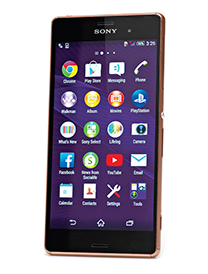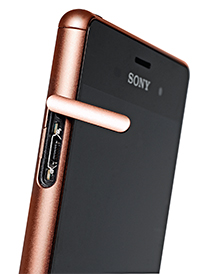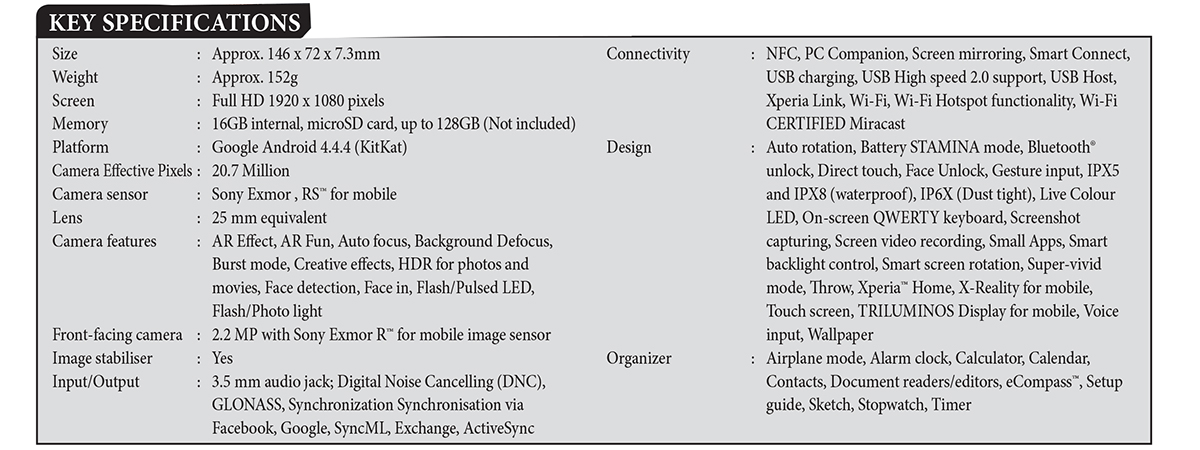 Barely two months after we reviewed the Xperia Z2, Sony released the Z3, an upgrade to the Z2. But we would consider this an attempt to arrest the price rather than a real upgrade. Hence we do not wish to go into the common features in detail.
Barely two months after we reviewed the Xperia Z2, Sony released the Z3, an upgrade to the Z2. But we would consider this an attempt to arrest the price rather than a real upgrade. Hence we do not wish to go into the common features in detail.
Design and Build Quality
The Xperia Z3 looks significantly different from Z1 and Z2. The body features the same front-andback glass design, but the Z3 has a slim and trim construction. Unlike the straight and slightly rough aluminium bezels of the earlier Z-series Smartphones, the Z3 has smoother and rounded aluminium bezel tipped with rounded, plastic corner pieces. Sony has done away with the microphone mesh (Z1) and the three microphone holes (Z2) at the base in favour of a horizontal slot on the front surface identical to its earpiece slot. This takes it closer to the iPhone 6 Plus in design (going by the published images of iPhone 6 Plus).
Key Features
Apart from the improvements in design elements and subtle changes in features, the Z3 is not very different from the Z1 and Z2.
Feature-wise, the Xperia Z3 is not significantly different from the Z2. Both feature the same Qualcomm Snapdragon 801 processor, but the Z3’s processor clocks slightly faster at 2.5 GHz against the Z2’s clock speed of 2.3 GHz. Both are powered by Adreno 330 GPU. Both provide 3GB RAM and 16GB internal memory, of which 11.8GB is available for the user. It can accept an external microSD card of up to 128GB. The device can also connect with an external USB storage (with an OTG cable), which provides virtually unlimited memory. The only change worth noting is that the Z3 offers PS4 remote play, which allows you to access your PS4 console remotely using WiFi. But this concerns only a handful of PS4 users.
The new phone has a higher ingress protection rating (IP68 instead of IP58), which may seem significantly higher, but is not so in reality. This only means that the Z3 is upgraded to dust-proof from dust-resistant. All other parameters remain the same.
The camera also has the same specifications, but the built-in effects have been improved in numbers. Still, this is not very significant. The camera feature the Z2’s 20.7-megapixel, 1/2.3- inch Type (6.16 x 4.62mm) Exmor RS for mobile sensor that was also used in the Z1. This high sensitivity sensor is believed to reduce digital noise while maintaining high resolution. The camera features a BIONZ for mobile processor, which aids in fast sutofocus, motion detection, and noise reduction. The camera features a Sony G 27mm equivalent f/2.0 lens. It also features a pulsed LED light that can function as a camera light and a torch. The Z3 is capable of recording 4K (3840 x 2160) Ultra High Definition videos. The camera features SteadyShot, which compensates for camera movements by boosting the sensitivity as required.
The Z3 uses a 5-inch Full HD IPS Triluminos Display with X-Reality for mobile technology. The display has a resolution of 1920 x 1080 pixels, which translates to a pixel density of 441 pixels per inch. It offers multi-touch feature with support for up to 10 fingers. The device measures approximately 146 x 72 x 7.3mm and weighs approximately 152g.
 Ergonomics
Ergonomics
Since the Z3 uses identical hardware as that of the Z2, everything remains the same. The screen is big, bright and clear. The device is slightly lighter and easily slips into the pocket. The camera interface is the same, with some subtle enhancements in the built-in effects. Buttons are rounded and overall, the device has soft contours.
Performance
Though we put the Z3 through the usual tests that we do with other Smartphones, we would not like to repeat what we said in the Z2 review since it is the same device in a re-designed shell. The phone and camera performed well, even while accessing resource-intensive applications. Images appeared crisp and the camera interface was quite userfriendly.
Native image size was 13.12 x 17.49 inches at 300 ppi. At 25 percent screen size, we observed slight noise at ISO 800. Observed at 50 percent of the screen size, slight noise was observed at ISO 400 and above. At 100 percent screen size, though the camera produced noise at all ISOs, images remained usable up to ISO 200. Auto White Balance performed well. Slight cast produced under artificial lighting could be easily removed in postprocessing. The Z3 particularly impressed us in close-ups.
Value for Money
The Xperia Z3 retails at an MRP of Rs.51,990. While the Z2 is listed at Rs.41,000 and the Z1 at Rs. 34,000. So the same or comparable hardware is marketed at steeply varying price-tags along with some subtle improvements. We would leave the judgement to you.

PLUS
• Powerful hardware
• Waterproof
• Dust Proof
• Good camera
MINUS
• Steep price
FINAL SCORE 83%
Design and Build Quality 19/20
Key Features 16/20
Ergonomics 17/20
Performance 17/20
Value for Money 14/10
VERDICT
The Sony Xperia Z3 is a high-end water and dust proof Smartphone that competes in the premium class of products. While it is good to have the latest product in the market (mainly due to the longer support commitments from Sony), the Z3 does not break any new barrier. But still it is a Best Buy.
Sujith Gopinath

